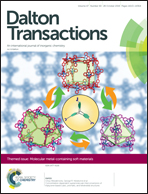Luminescent liquid crystalline hybrid materials by embedding octahedral molybdenum cluster anions with soft organic shells derived from tribenzo[18]crown-6†
Abstract
Crown ethers and their derivatives are versatile building blocks for the design of supramolecular materials. They can be functionalized at will and are well known for their abilities to complex with alkali cations. Here, we show that emissive lanthanide free hybrid materials can be generated by using such building blocks. The organic tribenzo[18]crown-6 central core was functionalized via six-fold Suzuki cross-coupling as a key reaction with three o-terphenyl units which could be converted into their corresponding triphenylenes by the Scholl reaction, leading to novel liquid-crystalline columnar materials. Selected tribenzo[18]crown-6 o-terphenyls could interact with emissive ternary metal cluster compound salts to generate hybrid materials combining the properties of both moieties. Due to synergistic effects and despite the anisometry of the cluster compounds, individual properties such as liquid-crystalline phase stability of the organic part and emission abilities of its inorganic counter-part are enhanced in the hybrid compounds.
![Graphical abstract: Luminescent liquid crystalline hybrid materials by embedding octahedral molybdenum cluster anions with soft organic shells derived from tribenzo[18]crown-6](/en/Image/Get?imageInfo.ImageType=GA&imageInfo.ImageIdentifier.ManuscriptID=C8DT03254H&imageInfo.ImageIdentifier.Year=2018)
- This article is part of the themed collection: Molecular metal-containing soft materials


 Please wait while we load your content...
Please wait while we load your content...